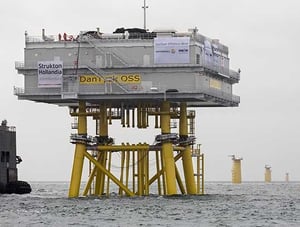
Rethink your risk models to leverage a competitive edge
Wind power is on the rise, but like any industry, the risks must be understood and mitigated.
In 2018 the wind power industry witnessed rapid growth, with €10.3bn being invested in Europe alone according to WindEurope. Despite this investment boom, driving cost efficiencies will be vital to ensuring wind power can continue to support an ongoing global energy transformation; a focus on evolving techniques, strategies and technology can enable these cost efficiencies to come to fruition.
Building a more robust business case requires a significant reduction, and management, of cost contingencies, more realistic installation schedules, and a clearer prioritization of project risks – for both new and seasoned developers alike. This can be achieved by rethinking the risk modelling on a project, moving away from a traditional risk register assessment, and instead applying statistical risk modelling.
Monte Carlo simulation, a form of probabilistic modelling where the outcome of an event is typically simulated 10,000 – 100,000 times, has been around for decades. However, this approach has only been adopted by wind power practitioners in the last eight to ten years.
New research by K2 Management illustrates significant upsides which can be gained by staying on top of risk analyses throughout the lifecycle of a project. The same applies when including opportunity calculations into risk scenarios throughout a project.
 For example, for every offshore wind project there is a chance that an internal lifting tool could break down or be damaged, resulting in severe delays and ballooning capital costs. Historically, such events would be included in a risk matrix, multiplying probability with impact, and then prioritized according to the perceived highest risk.
For example, for every offshore wind project there is a chance that an internal lifting tool could break down or be damaged, resulting in severe delays and ballooning capital costs. Historically, such events would be included in a risk matrix, multiplying probability with impact, and then prioritized according to the perceived highest risk.
Notably, a damaged internal lifting tool could have many different outcomes; a simple breakdown or damage that’s reparable; irreparable damage of the lifting tool, or in the very worst case, personnel injury. The consequences of each of these scenarios derived from the same event could have enormous differences both in terms of direct and affected capital expenses and delays.
On a typical offshore wind project, it’s not uncommon to identify 600 risks or more and each must be simulated 10,000 times to predict the correct contingency levels and to establish correlations between identified events. Additionally, the cost simulations should be integrated with schedule related risks to link asset burn rates to the cost simulation.
With modern technology, market knowledge about incidents and the correct risk formulas, it is possible to calculate different scenarios and probabilities, taking individual risk appetite into account.
Moreover, by recording all incidents that occur in similar projects, big data and machine learning can make the quantitative risk analyses significantly more accurate. There is huge potential in machine learning to collect the right and most comprehensive data for analyses spanning weather, finance, and macro-economic data, with potential to positively affect the risk models that we create.
Time is money
Not all risks on the register are expected to occur at the same time, so the overall contingency doesn’t need to be available to cover every eventuality at any given time. By dividing contingencies according to each project phase, cash flow can be optimized more accurately.
The existing approach sees project contingency spanning the entire project, but by doing it on a per-phase basis, we can reduce the contingency and reduce inflation exposure by ensuring the contingency is ready only when it is needed
For example, an 11 million EUR project in today’s terms will not have the same value at present as it will have five or ten years from now when the project is in construction or is operational ‑ an important consideration that should be reflected in the contingency set out across the lifetime of the project.
By revising contingency for each project phase, a developer can both optimize clients’ contingency without taking more risk, as well as give clients an opportunity to have the right amount of contingency set aside during each project phase instead of a whole-project fixed sum.
Taking a fresh perspective on risk modelling beyond the traditional risk register can not only shed new light on a project but can also make a greatly impact the business case by significantly reducing cost contingency, giving a more realistic installation schedule and showcasing a much clearer and prioritized map of project risks.



